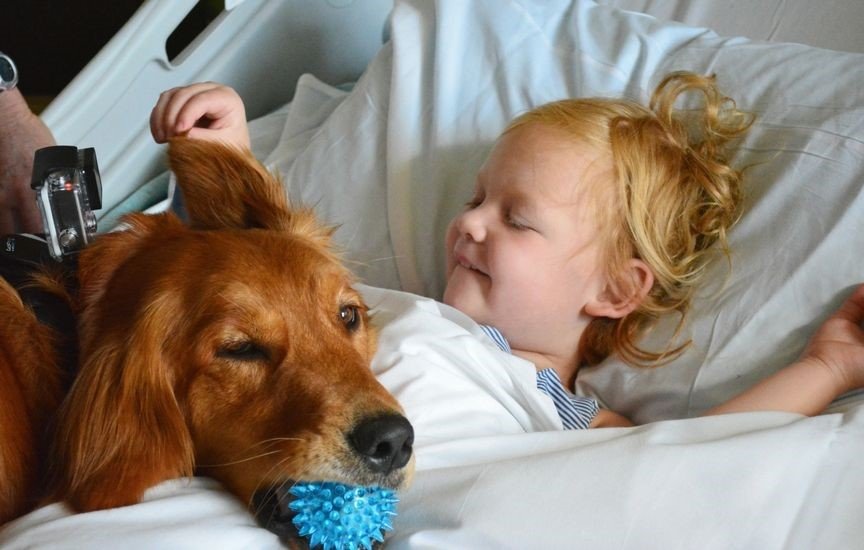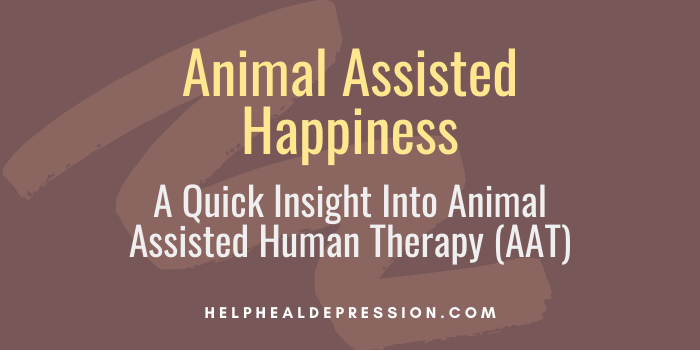Animal assisted happiness – there is a therapy called animal assisted human therapy, which can assist in feeling happiness and has many different applications and benefits.
Animals are such agreeable friends – they ask no questions, they pass no criticisms
We all are living in a very fast age. In the modern era, psychological issues are very common among people. This will not be wrong to say, that pets are one of the best antidotes for stress, depression, and other mental ailments in human beings. They have remarkable effects on the mood of humans – they help to feel happiness.
An excellent therapist has fur and four legs
In this article, we will cover some important points regarding animal-based human therapy and its all relevant aspects under the light of scientific literature and general field experience.

What Is Animal-Assisted Therapy?
Animal-assisted therapy (AAT) is an approach to facilitate psychologically troubled individuals in retrieving their normal lives and bring more happiness into their lives. In simple words, this therapy helps in normalizing the mental, social, emotional, and physical functioning of human beings with the help of a wide variety of animals such as dogs, horses, cats, birds, and many more. Remember, dogs are the most widely used animal in animal-assisted therapies. Also, note that animal-based therapies are only conducted under the supervision of a well-experienced professional in well-organized settings.
Animal-human bond is the basic strategy of animal-assisted human therapy
How Animal-Assisted Therapy Works?
Human-animal bond/interaction is used in this therapy. AAT is done under the supervision of an experienced therapist. Positive interactions with animals lead to the release of certain hormones/chemical messengers in the human body, which improve the mood, reduce anxiety, and depression.
Owning a therapy or companion animal, such as a dog trained to sense and alleviate anxiety, is only loosely considered a type of animal-assisted psychotherapy. AAT, by definition, involves the active participation of mental health professionals. Studies that evaluate the benefits of AAT generally do not include evidence gathered from this particular population.
Much more than simply spending time with an animal, animal-assisted therapy involves specific therapeutic goals, strategies, and outcomes measures. Therapeutic experiences can include walking, brushing, petting, and caring for an animal, as well as processing the experience of trying to achieve a given task.
There are many factors to keep in mind such as:
- Factors concerning the animal:
- Type of animal to be selected
- Health state of the animal
- Temperament of the animal
- Proper training of the animal
- Analysis of the patient:
- Requirements/needs of the patient
- Temperament/personality of the patient
- Allergies or other medical concerns of the patient
- Time of human-animal interaction. This totally depends upon the nature of the ailment and type of the animal that is being used. A therapist decides this according to the nature of the presented case. For example, sometimes it can start with 3 months twice per week and can be extended according to needs.
IMPORTANT POINTS
Evaluation of animal health
An important point is the overall health of the animal that is being used in the therapy process. Remember, the animal must be in sound health, free from chronic diseases or other potential health conditions that may interfere with the proper functioning of the animals during the therapy procedure. Also, note that the animal must be properly vaccinated. Check the vaccine schedule.
Evaluation of temperament of the animal
This is very much important to evaluate the temperament of the animal that is going to be used in the therapy procedure. In animal-assisted therapy, animals have to work in a much-stressed environment. Therefore, this is mandatory, to train the animal properly before using it in the therapy process. This is why test the temperament of animals for better outcomes of animal-assisted therapy.
Analysis of the patient
This is a very important point that must be kept in top priorities. A professional must have a proper idea about the requirements/needs of the patient who is undergoing animal-assisted therapy. Choose the type of animal according to the will & wish of the patient.
Applications of AAT
There are several mental and physical health benefits of animal-assisted therapy, which have been reported in human beings. Here are some key benefits of AAT:
1) AAT enhances the self-esteem and ability to care for oneself.
2) It builds up a sense of trust, empathy, and eagerness to participate in teamwork.
3) It enhances willingness to be involved in a therapeutic program or group activity.
4) It reduces hostility towards others and oneself along with encouraging a sense of empowerment.
5) It has a significant influence on the reduction of anger and aggression.
6) It helps in dealing the depression, anxiety, mood disorders, personality disorders, and other psychological troubles.
7) It helps (socially sick) individuals to improve their social life (makes them friendly and helps them growing their social circle by interacting with the animals).
8) This therapy has positive effects on the cardiovascular health of humans such as it lowers blood pressure.
9) It improves fine motor skills in children along with the ability to focus and concentrate on different tasks.
10) It refines the coordination.
11) It decreases the requirements of medications and empowers greater self-control.
In addition to that, animal-assisted therapy can also be used to help treat autism spectrum disorder, addiction, cancer, heart disease, dementia, developmental disorders, psychiatric disorders such as schizophrenia, emotional and behavioral disorders and chronic pain. It helps in easing the stress and anxiety of the patients. It helps in coming out of the mental trauma.
AAT boosts up the spirit and reduces boredom, anxiety, depression (list of therapies to treat depression) and feelings of alienation.
Where to Conduct AAT?
Interestingly, animal-assisted therapies can be held in any setting including hospitals, prisons, homes, and therapeutic boarding homes for teens and other mental health care facilities. Moreover, this kind of therapy can be conducted individually or in the form of groups only under the supervision of an expert therapist or professional trainers.
Is AAT Suitable For All Age Groups?
This type of therapy can be beneficial for all age groups. You can see significant improvement in the behavior and interpersonal relationships in young children. For instance, young children who are unable to express physical and emotional comfort and closeness with others, or find it difficult to do so, may more readily form that type of bond with a horse or other animal.
This bond between animals and children can help them to develop positive traits in their personality such as patience, empathy, acceptance, confidence, activeness, and much more.
Research studies have also shown that these animal-assisted therapies are very beneficial for aged and elderly people. Animal-assisted therapy can be especially productive for people who used to have dogs or other animals but are no longer able to care for their own animal. Being in the presence of pets again can help remind people of the love they had for previous animals, stirring nice memories and reducing loneliness.
SUMMARY – Animal Assisted Happiness Therapy
Animal-assisted psychotherapies have a wide range of applications in assisting and improving with many ailments in human beings, but special precautions must be taken while dealing with the animals. Different animals show a variety of behaviors, as horses can pose a high risk of danger to children, because of their large weight and size. Therefore, there is a need for some exercises and training.
Besides, some people experience allergies and other medical concerns while coming in contact with animals and their environment.
There is always a need to consult a health expert/trainer while undergoing any animal-assisted therapy, as better decisions and strategies can bring you better outcomes.
AAT is a highly accepted therapy among patients, also because they have immediate personal feedback about how they feel – they can often notice positive changes in the way they feel already during and after every session. Often animal assisted happiness is part of the result.
AAT is a professional and acknowledged therapy. Look for a certified professional, if you are interested in AAT.
FREQUENTLY ASKED QUESTIONS
What are the risks of animal-assisted therapy?
All along with several health benefits, there are some potential risks, which are associated with animal-assisted therapy. For example, Allergies to pet, safety concerns, patient possessive behavior, grief reactions, and affiliation issues.
Why is it important to train animals before using them for AAT?
As you know, each animal has certain behavioral patterns (instincts), which you simply call temperament. It is important to teach the animal proper behaviors/commands before using them in AAT. This is essential from the safety point of view of both patient and the animal.
Is animal-assisted therapy good for children?
Yes, many scientific studies have proven that animal-assisted therapy gives many health benefits to children. It has an astounding role in improving the self-esteem of children, improves their social lives, and helps regulate their mental and physical health along with enhancement of the sense of responsibility.
Can AAT help children in overcoming speech and emotional disorders?
Yes, AAT has a significant role in dealing with speech and emotional disorders in children.
How can your dog become a therapy dog?
To be a therapy dog, it has to go through several training sessions. After getting certifications, the dog can be used for AAT. Remember, a therapy dog must be at least one year old.
How are horses used in AAT?
Horses are used in animal-based therapy, but only under highly controlled professional supervision. It requires great expertise to handle the horses and exploit them in AAT. If you want to find out more, search for: Equine therapy, also known as Equine-Assisted Therapy (EAT).
Are there books about animal assisted therapy?
Yes, there are several books available on this topic. You can check out the books on amazon – animal assisted therapy.
How to become an animal assisted therapist?
After getting proper certifications in animal based psychotherapy, you can become an ATT therapist. However, criteria to become an ATT therapist varies from country to country. Check out which professional certifications are necessary to be an ATT therapist in your country. Generally, health-care professionals, veterinarians, psychologists and social workers get certifications to be AAT experts. Working with animals and helping others with the help of animals is a very nice job. When you become an animal assisted therapist, you will be directly involved in the process of facilitating animal assisted happiness.
